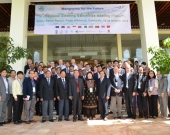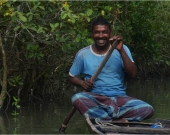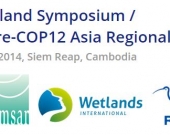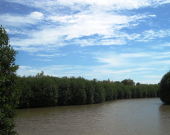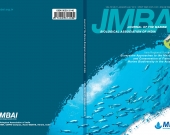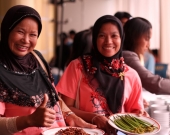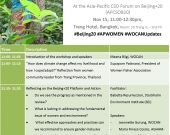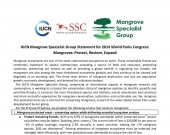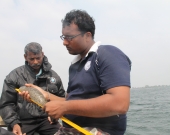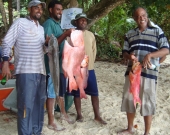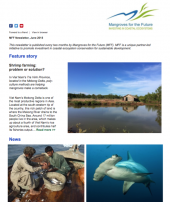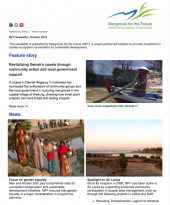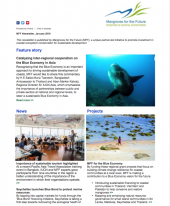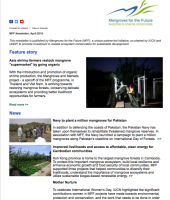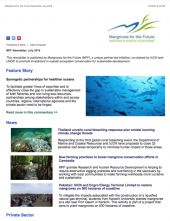Newsroom :: Newsletter :: MFF Newsletter 33
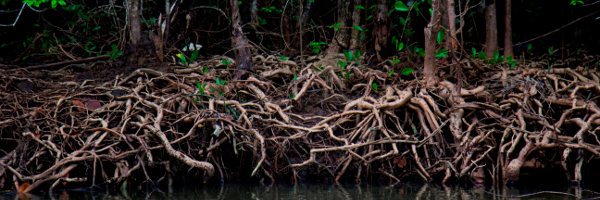
|
Mangroves for the Future Newsletter - Issue 33
1st Oct 2014 - 31st Dec 2014
I am pleased to send you the latest issue of the Mangroves for the Future (MFF) newsletter. It has been an exciting few months, with growth in our member countries, our regional annual meeting in Cambodia and preparations being made for a number of new initiatives that will lay the groundwork for how we move forward.
As you will read below, we have recently developed two new strategies for how we integrate gender considerations into MFF programming, and how we fully engage private sector in our efforts. Both these strategies have important implications for the sustainability of the MFF initiative in the long term – ensuring that all stakeholders are engaged, and that we fully explore all potential sources of financing.
On the outreach front we have presented MFF work at two major events and raised the profile of the importance of protecting mangroves and other coastal ecosystems. This included a presentation at the World Parks Congress in Sydney, Australia, a landmark event which happens only once every 10 years and which brought together more than 5,000 protected area managers along with representatives of civil society, government and the private sector.
Finally, we extend a warm welcome to Myanmar as the newest member country of MFF, approved at the recent Regional Steering Committee meeting in Cambodia. There is huge opportunity and need in Myanmar for investment in coastal ecosystems and communities, and we look forward to supporting the newly formed National Coordinating Body as they move this forward.
As always, thank you for your support.
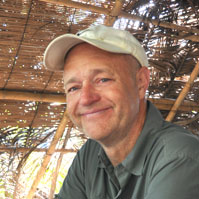
Steen Christensen
Coordinator
Mangroves For The Future
MFF online survey
Please take a short online survey to help make the MFF newsletter better: Take Survey
Regional Activities
Building Coastal Resilience in the Face of Climate Change: RSC-11
Sihanoukville, Cambodia 25 Oct 2014
Representatives from all the MFF countries gathered in Sihanoukville, Cambodia in October for the 11th meeting of the MFF Regional Steering Committee. The meeting marked the launch of MFF's new phase of funding for 2014-2018, and also saw the number of member countries grow with the addition of Myanmar, the 11th member country. A number of important decisions were made about how to improve the effectiveness and focus of MFF grant giving as well as how to maximize project impact. A learning event following the official meeting focused on exploring new potential areas of sustainable financing for integrated coastal management.
Ecosystems across Borders: MFF at the World Parks Congress 2014
Sydney, Australia 18 Nov 2014
MFF recently took part in the IUCN World Parks Congress in Sydney, Australia, an event that takes place only once every 10 years, and which focuses on conservation and management of the world's Protected Areas. More than 5,000 people gathered to attend myriad sessions and side events, and to take part in creating the Promise of Sydney, an ambitious agenda to safeguard the planet’s natural assets. MFF hosted a congress side-event that highlighted best practices in trans-boundary ecosystem management in Asia, including the unique MFF governance model.
Mangroves identified as important wetlands for disaster risk reduction at Asian Wetlands Symposium
Siem Reap, Cambodia 06 Nov 2014
MFF and the IUCN Water and Wetlands Natural Resources Group were recently identified as Asia focal points for the RAMSAR Pre COP 12 meeting which was held in Cambodia in early November as part of the Asian Wetlands Symposium. The meeting brought together representatives from government, civil society, private sector and local communities to discuss approaches and priorities relating to the conservation and wise use of wetlands in Asia and the Draft Resolutions that will be presented at the RAMSAR COP 12 in Uruguay on June 2015. MFF presented on the continuing issues and threats to mangrove conservation and management across South and Southeast Asia and highlighted the importance of conserving healthy intact mangrove forests as part of holistic wetlands management and disaster risk reduction.
The Business of Mangroves
Ca Mau, Viet Nam 01 Dec 2014
Coastal tourism and fisheries and aquaculture are the target industries for a new private sector engagement strategy that has recently been developed for MFF. MFF has long recognized the critical importance of harnessing the financial capacity and entrepreneurial spirit of the private sector in support of protecting coastal ecosystems, and its unique governance structure sees private sector representatives sitting at the table with government and NGOs as part of the National and Regional Coordinating Bodies.
Journal of Marine Biology Association of India publishes proceedings from Fisheries Symposium
Kochi, India 03 Nov 2014
The proceedings from the Fisheries Symposium held in Kochi, India in October 2013 have been published in a Special Edition of the Journal of Marine Biology Association of India. This regional symposium brought together representatives from more than 12 countries with the goal of exploring ecosystem-based approaches to protecting fisheries and marine biodiversity in South and Southeast Asia, and to share practical science-based solutions to fisheries issues.
New regional Gender Advisory Panel to advance gender strategy in MFF
Bangkok, Thailand 27 Aug 2014
On August 27 MFF convened a meeting of gender practice leaders and IUCN senior managers at the IUCN Asia Regional Office, for an initial discussion on the establishment of a regional Gender Advisory Panel for MFF and for IUCN Asia, endorsing the importance of gender as a critical component of IUCN and MFF environmental programmes and projects.
Reflecting on the Beijing+20 Platform and Action for Gender: Asia-Pacific CSO Forum
Bangkok, Thailand 15 Nov 2014
MFF, in partnership with Women Organizing for Change in Agriculture and NRM (WOCAN), joins the conversation about women and environment policies in action, at the lead up to the regional review of the Beijing+20 Platform for Action review this 17-20 November in Bangkok, Thailand.
World Parks Congress called to Protect, Restore and Expand Mangroves
Sydney, Australia 17 Nov 2014
As part of the 2014 World Parks Congress in Sydney, a Call to Action Statement on mangrove protected areas was presented November 17 by the IUCN Mangrove Specialist Group. The Statement recognises that protected areas are a vital tool for conserving mangroves, as part of a wider Global Action Plan for mangroves conservation.
Country Updates
Fishing for sea cucumbers – how long?
Colombo, Sri Lanka 16 Nov 2014
This article has previously published in the Sunday Times on 16 November 2014. The author is Dr Sriyanie Miththapala, Consultant to IUCN Sri Lanka
Helping protect Praslin Island's fish resources
Praslin, Seychelles 01 Dec 2014
Praslin is the second largest inhabited island in the Seychelles archipelago. A large portion of the fish catch of Praslin comes from the artisanal trap fishery that mainly targets rabbitfish (Siganidae) and parrotfish (Scaridae). Rabbitfish is particularly vulnerable from overfishing as it forms large spawning groups at specific times and places. On Praslin, fishers know about the locations and timing of these groupings and have exploited them extensively over the years.
Recent MFF Resources
MFF Newsletter June 2015
Publication Date: 15 Jun 2015
Author: IUCN Asia
Quarterly published MFF Newsletter.
Download the full report »MFF Newsletter October 2015
Publication Date: 15 Oct 2015
Author: IUCN Asia/ MFF
Quarterly published MFF Newsletter
Download the full report »MFF Newsletter January 2016
Publication Date: 11 Jan 2016
Author: IUCN Asia/ MFF
Quarterly published MFF Newsletter
Download the full report »Links, Resources and Publications
- Investments for resilient communities: SGF projects in Bangladesh, 2013-14
- Framing ecosystem-based adaptation to climate change: Adaptations in Bangladesh context
- Special issue, Journal of the Marine Biological Association of India, on the Asia Regional Symposium on Ecosystem Approaches to the Management and Conservation of Fisheries and Marine Biodiversity in the Asia Region
- Mangroves for Coastal Defence: Guidelines for coastal managers & policy makers
- The Importance of Mangroves to People: A Call to Action (UNEP Report, 2014)
- New UNEP reports on carbon potential of mangroves launched at the UNFCC
